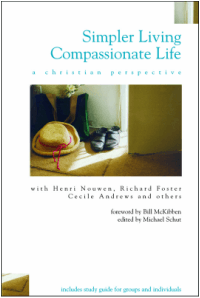To see a general overview of Simpler Living, Compassionate Life click here.
In this section: “Spending Money as if Life Really Mattered” by Evy McDonald (59-66); “Money” by William Stringfellow (67-72)
Many people are uncomfortable talking about money. Discussion of income, savings, or giving often makes people blanche. The taboo that the American culture places on talking about money makes conversations of faithful stewardship of one’s money difficult. However, McDonald and Stringfellow bring nuanced approaches to bear in this section, which is the first to really analyze our use of money.
McDonald shares her realization that time = money. She reflects on how her life, especially as a consumer, changed when she began asking whether an item she was considering purchasing was worth the hours of work it would take to make the money needed to buy the item. If an item is not worth the time, she moves on. McDonald’s essay doesn’t vilify money, but encourages readers to become thoughtful consumers.
Stringfellow holds a mirror to the idolization of money. His essay recognizes that the obsession with money has made it a moral measure as well. We’ve come to believe that more money = moral excellence. Stringfellow calls for freedom from this idol. He affirms that money itself is not bad, but our placing money and the acquisition of money above God is wrong.
This section calls the reader to question their own relationship with money, which is helpful preparation for later sections that will widen the scope, turning to larger societal structures.
After Simpler Living, Compassionate Life, Michael Schut also published Money and Faith: The Search for Enough. To learn more about this publication click here to be taken to his website.








